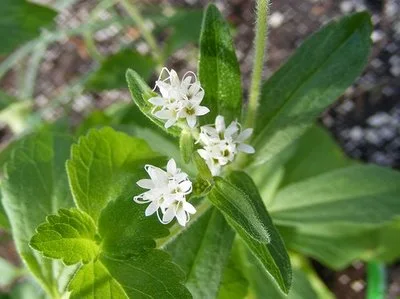Growing Stevia
Stevia (Stevia Rebaudiana)
Stevia is a delicate perennial that should be planted in light, sandy soil with a neutral pH. Give it full sun and wait to transplant it until the soil warms up in spring. Once the evenings start getting into the 60s and your tomato plants start to put on some growth, stevia should to do well. Stevia likes rich soil, so compost it well. Space plants 18 inches apart, and keep them uniformly moist but not wet. Mature plants will grow to two and a half feet high.
Propagating Stevia
Notoriously difficult to germinate, stevia is best propagated from cuttings. Premier plants will be those with the highest concentrations of stevioside, a big part of what makes the plant so sweet. Once you have a sweet plant, take cuttings in fall and keep young plants indoors till spring.
If you want to try propagating stevia from seed, choose the darkest seeds for next year's crop, and plant more seeds than you think you'll need . . . lots more. Even the few that take might not be sweet, so taste your plants and take cuttings and seeds from the sweet plants only.
Harvesting Stevia
Harvest your stevia crop in the fall before the first frost. The leaves will be much sweeter than the stems. Sun dry leaves or use a dehydrator. Once the leaves are crackling dry, store them in an airtight container in a dark place.
Using Stevia
Stevia can be used in cooking and baking. Depending on the plant, it can be many times sweeter than sugar . . . possibly as much as 15 times sweeter. Do some testing to see how your plant tastes. Stevia can be used fresh or dry. You can also boil it in water and make a sugary syrup from it.
 If you've tried the processed stevia sweetener available in your local market and didn't like it, home grown stevia has a more natural, less chemical flavor. It tastes great in beverages and desserts; just grind the leaves fine. Think of it as another way of going green in the kitchen.
If you've tried the processed stevia sweetener available in your local market and didn't like it, home grown stevia has a more natural, less chemical flavor. It tastes great in beverages and desserts; just grind the leaves fine. Think of it as another way of going green in the kitchen.Health Benefits of Stevia
There have been many studies of the stevia plant, particularly in Japan. With all the concerns about artificial sweeteners, this isn't so surprising. Some of the evidence is encouraging. Stevia shows promise in regulating blood pressure and as an anti-bacterial agent. It has been linked to controlling tooth decay, gum disease and warding off colds and flu.
Processing any herb for mass production involves changing it in some way, so growing your own stevia plants makes sense if you want a safe sweetening option.
Hungry for some stevia fun facts? Visit my last post: Understanding Stevia.
If you grow stevia and want to make a sweet syrup with it, visit: How to Make Stevia Syrup
------------
Photo1 - Stevia3_Wiki.jpg By Gabriela F. Ruellan (Own work) [CC0], via Wikimedia Commons http://upload.wikimedia.org/wikipedia/commons/0/0f/Stevia_rebaudiana_%28potted_plant%29.jpg
Stevia photo (2) courtesy of Tamara Dourney at Flickr. You can also visit her at: Saponifier


I use stevia in my beef stew. I used to use brown sugar to give it enough sweetness so the kids will eat it. I feel much better getting the taste to their liking with stevia. Great post. Thank you.
ReplyDeleteI start to plan stevia this year, I think it does like too much water, hope it will grow well like yours.
ReplyDeleteWould you mind giving me the recipie for the stevia sugar syrup? Would I be able to add another herb to it like Lemon Balm or Lemon Verbeana?
ReplyDeleteThanks!
♥
Hi,
ReplyDeleteI've just posted a stevia syrup recipe with some tips and tricks for adding additional flavors.
Good luck.
Sara
Thanks!
ReplyDelete♦♦